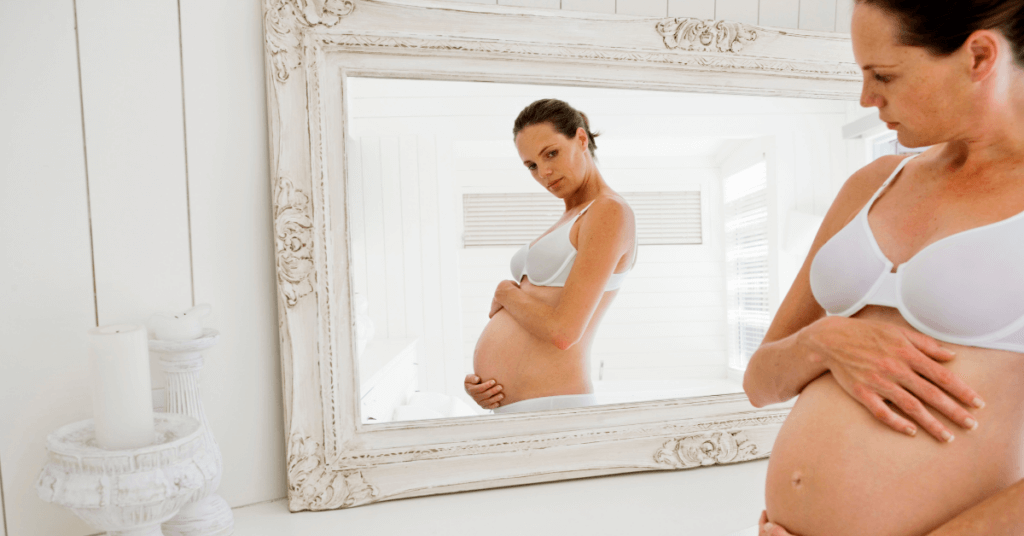Pregnancy is a journey full of constant change. As you are preparing, physically and emotionally, to bring a new life into the world, you may find your body changing in new and unexpected ways. Understanding how skin and hair changes during pregnancy can help ease stress and help you enjoy your pregnancy.
Understanding How Skin and Hair Changes During Pregnancy

Let’s calm your anxieties about the skin and hair changes that can occur during pregnancy. In this article, we’ll walk you through common pregnancy skin and hair changes, as well as tips for taking care of your skin and hair’s health and beauty, both during pregnancy and postpartum.
What Causes Hair And Skin Changes During Pregnancy?
According to the American College of Obstetricians and Gynecologists (ACOG), some of the skin changes that occur during pregnancy are due to the changes in hormone levels that are happening at the same time.
Increased blood flow and oil production that happens when you’re pregnant, often contributing to what’s referred to as a “pregnancy glow”, can lead to more acne, and a natural increase in melanin during pregnancy can result in dark spots. And for many skin changes, healthcare professionals are unsure of the exact cause.
Like skin, pregnancy hormones are thought to be responsible for the hair changes that women experience during pregnancy, specifically changes in estrogen levels.
How Pregnancy Can Change Skin
Some of the common pregnancy skin changes include:
- Dark spots on your breasts, nipples, or inner thighs
- Brown patches on the face, also known as melasma
- A dark line running from the navel to the pubic hair, also known as linea nigra
- Acne
Many women also find new stretch marks during pregnancy—pink or red stripes which can develop wherever there is rapid growth and stretching of the skin. Unsurprisingly, you might find these on your stomach, breasts, buttocks, and thighs as your body changes throughout your pregnancy.
Spider veins and varicose veins are other skin conditions some women experience while pregnant. Spider veins are very small red veins that can appear on your face, neck, and arms. They are most common during the first half of pregnancy and usually fade after delivery.
Varicose veins are swollen, sore, and blue veins in your legs, caused by the weight of your uterus decreasing blood flow from your lower body. They can also appear on your vulva or in your vagina or rectum (also known as hemorrhoids). You’re more likely to get varicose veins if someone else in your family has had them, and similarly to spider veins, they usually go away after your baby is born.
How Pregnancy Can Change Hair
Pregnancy brings a lot of dramatic changes to a woman’s body, and hair is no exception. Here’s a rundown of what you might experience:
1. Increased Hair Growth
Due to higher levels of estrogen and increased blood flow, pregnant women often notice their hair growing faster and thicker. The good news is that you might have a lot of hair during pregnancy, giving you that luscious look.
2. Hair Texture Changes
Hormonal changes can also affect the texture of your hair. Some women find their hair becomes curlier or straighter than usual.
3. Less Hair Shedding
Normally, hair follicles go through a growth phase (anagen phase) and a resting phase (telogen phase). During pregnancy, the higher hormone levels can prolong the growth phase, leading to less shedding and fuller hair. Conversely, some women may experience a decrease in estrogen during pregnancy, due to stopping the oral contraceptive pill or a hormonal imbalance. This can lead to more hair falling out than usual.
4. Body Hair in Unwanted Places
Increased hormone levels, especially androgens, can cause hair growth in new or unwanted places, like the belly button, pubic area, or even the upper lip.
5. Telogen Effluvium
After giving birth, many new moms experience a condition called telogen effluvium, where the hair that was in the prolonged growth phase shifts to the resting phase and falls out, leading to postpartum hair loss. This can be quite alarming but is usually temporary. Many women who experience thicker hair during pregnancy notice unusual hair loss around 3 months after giving birth, as their hormone levels and hair cycles of growing and falling out are all returning to normal. Usually, your hair will grow back normally within 6 months post-delivery.
6. Changes in Hair Follicles
Pregnancy hormones can alter the size and shape of hair follicles, sometimes leading to changes in hair texture or thickness.
7. Scalp Conditions
Some women might develop itchy skin or pruritic folliculitis during pregnancy, which are itchy red bumps on the scalp.
In short, pregnancy can bring about a myriad of changes to your hair, from increased growth to texture changes, and even postpartum hair loss. These changes are all part of the fascinating ways your body adapts during this special time.
Tips for Healthy Skin During Pregnancy

When it comes to skincare during pregnancy, there are certain things you’ll probably want to avoid, and other things that will help your skin look and feel its best. Let’s start with the do’s.
Do:
- Wear sunscreen and/or a hat while in the sun to minimize the occurrence of dark spots. You may consider using mineral sunscreen over a chemical one, as oxybenzone (the most frequently used ultraviolet filter in chemical sunscreens) has been linked to endocrine disruption and fetal damage. You can also decrease the amount of time you spend in the sun, paying particular attention to avoiding peak hours of 10 am – 2 pm.
- Wash your face daily with a gentle cleanser.
- Treat your acne with over-the-counter products. According to the American Academy of Dermatology Association, azelaic acid, benzoyl peroxide, and salicylic acid are generally considered safe to use for a limited time, though they recommend you still consult your doctor before using them while pregnant.
Don’t:
- Use isotretinoin or tazarotene, which are vitamin A derivatives that can cause severe birth defects in fetuses.
- Take doxycycline, minocycline, or tetracycline, from once you’ve reached week 15 of your pregnancy until after delivery.
- Take acne medication, like spironolactone, that blocks specific hormones.
Tips for Healthy Hair During Pregnancy

Hair care during pregnancy doesn’t necessarily need to look much different than it did for you before. You shouldn’t have to change which shampoo, conditioner, or other hair products you use unless you use a prescription dandruff shampoo. In that case, you should consult your doctor, as some medicated shampoos aren’t safe for use during pregnancy.
Another reason you might switch up what you use on your hair during pregnancy is if the smells become overwhelming. Some women experience extra sensitivity to scent while they’re pregnant, and if you find that to be true for you, consider switching to fragrance-free hair care products.
As for whether or not it’s safe to dye, highlight, or perm your hair during pregnancy, doctors’ opinions are mixed. Some recommend stopping, others say it’s fine to continue, and some say you should specifically avoid these treatments in the first trimester, after which you can do them. Very few studies have examined the effects of hair chemicals on pregnant women—so while there is a chance that harsh chemicals can be absorbed through your scalp and passed to your baby, the research is not definitive. Consult your doctor so you can make an informed decision that factors in your own risk tolerance.
One recommendation that has more consensus among doctors is to avoid hair straightening treatments that contain formaldehyde if possible, as it’s a known carcinogen.
How To Take Care Of Your Skin And Hair Postpartum

After giving birth, your skin and hair may want some extra pampering. Postpartum skincare and hair care is all about tuning into what your body needs, while still being mindful of products with harsh chemicals to consider avoiding if you’re breastfeeding.
Your skin and hair should return close to their normal state within 6 months post-delivery, perhaps after some postpartum acne or hair loss. Do your best to be patient with this process and honor the monumental changes your body has gone and continues to go through.
Additionally, stress and overall health are linked to your skin and hair health, so prioritizing things like drinking lots of water, eating nutrient-rich foods, and resting whenever you get the chance could contribute to glowing skin and strong, healthy hair.
Postpartum Hair Care:
- Telogen Effluvium: As mentioned above, this is a natural process where the hair that was in the growth phase during pregnancy shifts to the resting phase and falls out. Don’t worry, this usually resolves on its own.
- Gentle Hair Products: Use mild shampoos and conditioners. A leave-in conditioner can help manage any changes in hair texture.
- New Hair Growth: Be patient as your hair follicles adjust. You might notice new hair growth a few months postpartum.
Still Worried?
If you’re worried about a skin or hair condition that seems more serious, like rashes that don’t go away or excessive hair loss, don’t hesitate to speak with your healthcare provider. They can help you get to the bottom of what’s going on and take appropriate action.
Persistent Skin Problems
Conditions like pruritic folliculitis of pregnancy, pemphigoid gestationis, and prurigo of pregnancy can sometimes continue postpartum. These skin diseases often require medical intervention, so it’s important to consult a healthcare provider if you notice persistent or severe rashes, red bumps, or itchy skin.
Severe Hair Loss
While some hair loss is normal, excessive hair loss beyond typical telogen effluvium might signal other issues, like thyroid imbalances or nutrient deficiencies. Your healthcare provider can conduct blood tests to check your hormone levels and other markers to determine if there’s an underlying condition.
Varicose and Spider Veins
If your varicose veins or spider veins are causing discomfort or pain, your doctor can suggest treatments like compression stockings, lifestyle changes, or in some cases, medical procedures to alleviate the symptoms.
Skin Changes
If dark spots, dark patches, or the mask of pregnancy don’t fade or worsen, it’s important to get a professional opinion. Some skin changes might require treatments like topical creams or laser therapy to improve.
Unwanted Hair Growth
Excessive body hair or pubic hair growth in unwanted places can sometimes be managed with methods like laser hair removal, but it’s best to get advice from a healthcare provider to ensure these treatments are safe for you.
Nail and Hair Texture Changes
If you notice significant changes in your nail growth or hair texture, it might be a sign of hormonal fluctuations or nutritional deficiencies. Your healthcare provider can guide you on the best supplements or treatments to restore normal levels.
Autoimmune Responses
Some skin conditions and hair changes can be linked to autoimmune diseases. If you have symptoms like severe itching, unexplained rashes, or hair loss, your healthcare provider might investigate further to rule out any autoimmune response.
Remember, as a new mom, your body is still adjusting postpartum. If something feels off, trust your instincts and seek medical advice. Your healthcare provider is there to support you through these dramatic changes and ensure both you and your baby are healthy.
Final Thoughts on How Skin and Hair Changes During Pregnancy
In summary, it’s normal to experience skin and hair changes during and even after pregnancy. Don’t hesitate to reach out to your healthcare provider if you’re experiencing any concerning symptoms. They can offer reassurance, run necessary tests, and provide treatments tailored to your needs, helping you feel your best during this special time.
Disclaimer: All content within this site is not intended as medical diagnosis or treatment and should not be considered a substitute for, nor does it replace, professional medical advice, diagnosis, or treatment. You are solely responsible for ensuring that any health or nutritional information obtained is accurate.




